





© Montreal Locations Scouts 2018

Header photo Copyrights: http://en.wikipedia.org/wiki/Old_Montreal

Champ de Mars
A huge public expanse surrounded by trees, the perfect place to
relax and soak up some sun... a superb view of downtown
Montréal... and fascinating historical remains.
Can you pick out the two lines of stone running across the surface
like a double backbone? This is one of the few spots in present-day
Montréal where you can still see physical evidence of the fortified
town of yesteryear.
In 1991, the site was developed to highlight the remains of the
fortifications. Trees that recall the Commissioners’ plan stand
guard over this unique legacy.
Credit/Copyrights: http://www.vieux.montreal.qc.ca/
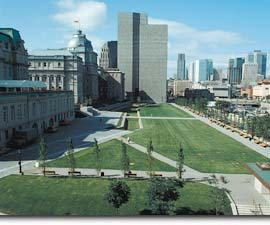
Rue Notre-Dame East
For centuries now, this is where different, and often conflicting,
visions of the city have been championed, where decisions have
been made and trials heard. The times have changed, of course.
Today there are women sitting as judges and on City Council, and
nearly as many couples come to the Courthouse for divorces as
for marriage licences.
But the weight of the solid stone surroundings still lends gravity
to the political and legal proceedings.
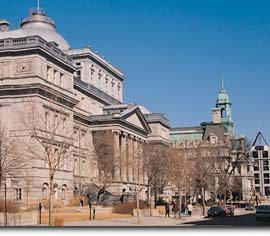
The Château Ramezay was one of the first buildings in Québec to
be declared a historic monument. It is named for Claude de
Ramezay, Governor of Montréal, who had it built as his home in
1705. The Château was later sold to the Compagnie des Indes,
which held a monopoly on fur exports, and was remodelled and
expanded in 1756, partly on its original foundations. The building
served as a Governor's residence again and later as a military
headquarters and courthouse, and finally was turned into a
museum in 1895. A turret, added in 1903, makes it look even more
like a castle, a name derived from its delightful architecture, typical
of a hotel particulier in the days of the fortified city.
Montréal City Hall has a more turbulent history than its peaceful
façade suggests. The building went up between 1872 and 1878,
and survived a severe fire in 1922. And it was from this balcony
that French President General de Gaulle uttered his famous "Vive
le Québec libre!" during a state visit in 1967.
Credit/Copyrights: http://www.vieux.montreal.qc.ca/
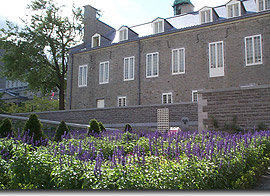
Credit/Copyrights:
http://www.vieux.montreal.qc.ca/
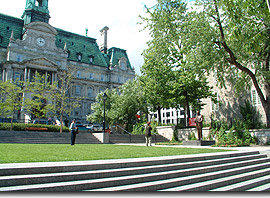
Bonsecours

The Bonsecours Market, a jewel in Montréal's heritage crown,
was inaugurated in 1847. A symbol of Montréal's heyday, this
imposing building was the city's main agricultural marketplace for
over a century. It also housed a concert hall and even served as a
city hall in the early days of Montréal.
Its symmetrical composition and Greek Revival portico (the cast-
iron columns were brought from England), tin-plated dome and
simple and varied details make it a perfect illustration of the Neo-
classical style in favour at the time. Recent renovations have
turned it once again into a bustling marketplace that also features
shops and exhibitions. Credit/Copyrights: http://www.vieux.montreal.qc.ca/
A beautiful house in the fortified town
The Pierre du Calvet house, built in 1770 and nicely restored in 1966, is an
impressive sight. But in the 18th-century fortified town, the customers of the
owner, a Huguenot merchant and supporter of the American Revolution, probably
saw nothing unusual about the building. With its steeply pitched roof, its
fieldstone walls secured with "S"-shaped iron bars and its casement windows, it
was typical of the period. Note the end walls, which extend above the line of the
roof as fire breaks. This type of construction became mandatory after the great
fire of 1721.
Credit/Copyrights: http://www.vieux.montreal.qc.ca/
Montréal City Hall has a more turbulent history than its peaceful
façade suggests. The building went up between 1872 and 1878, and
survived a severe fire in 1922. And it was from this balcony that
French President General de Gaulle uttered his famous "Vive le
Québec libre!" during a state visit in 1967. (Listen closely and you can
still hear the crowds roaring.)
Credit/Copyrights: http://www.vieux.montreal.qc.ca/

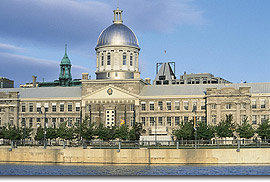
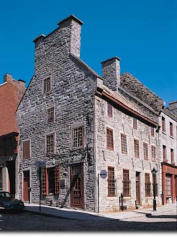
Place Jacques-Cartier

The square was built here by the city in the first half of the 19th
century, but this initiative was simply an acknowledgement of a
much older reality. As archaeologists have found, people have
gathered at this site for generations. It has always been one of
the most popular spots in Montréal! shops and exhibitions.
When the Bonsecours Market opened for business in 1847, the
"old" New Marketplace was demolished and turned into Place
Jacques-Cartier. Market gardeners and craftspeople continued to
offer their wares as an outdoor extension of the New
Marketplace, however.
When the Bonsecours
Market opened for business in 1847, the "old" New Marketplace
was demolished and turned into Place Jacques-Cartier. Market
gardeners and craftspeople continued to offer their wares as an
outdoor extension of the New Marketplace, however.
Built during the same period, these houses mark changes in
architectural styles after 1800, notably the use of cut stone
façades.
Credit/Copyrights: http://www.vieux.montreal.qc.ca/
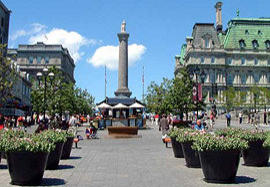
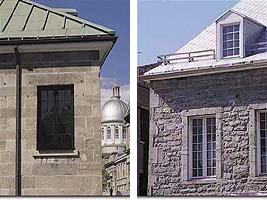

Rue Saint-Amable

On Rue Saint-Amable, you find yourself surrounded by the ebbing
and flowing crowds; shopkeepers and artists call out to you,
employing all their charm and talent to sell their wares. In days
gone by, voices also echoed from these stone walls—discussing
politics, as always, and the recent price hikes... for beaver pelts.
In the inner courtyards, shopkeepers and craftspeople seek your
custom, just as they always have. The products may change, but
business endures...
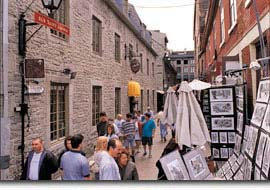
Rue Saint-Paul

Now we are on Montréal's oldest street. Here, at the confluence of
the city and the Port, warehouse-shops once welcomed
customers through their front entrances on Rue Saint-Paul and
brought in goods through their back doors on de la Commune.
Art galleries, shops, restaurants, shows at Deux Pierrots... Rue
Saint-Paul has regained its former vibrant character with the
rediscovery of Old Montréal.
Credit/Copyrights: http://www.vieux.montreal.qc.ca/
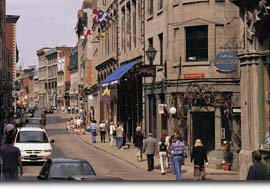
Websites:


http://beauchemin-dezainde.com (Site Français)
http://beauchemindeze.com
http://montreal-photography-productions.com
http://montreal-locations-scouts.com
http://quebec-photography-productions.com
http://dominican-republic-locations-scouts.com
http://dominican-republic-photography-productions.com
http://punta-cana-locations-scouts.com
http://las-terrenas-photography-productions.com
http://samana-photography-productions.com






Champ de Mars
© Montreal Locations Scouts 2014

Header photo Copyrights: http://en.wikipedia.org/wiki/Old_Montreal
A huge public expanse surrounded by trees, the perfect place to relax and soak
up some sun... a superb view of downtown Montréal... and fascinating historical
remains.
Can you pick out the two lines of stone running across the surface like a double
backbone? This is one of the few spots in present-day Montréal where you can
still see physical evidence of the fortified town of yesteryear.
In 1991, the site was developed to highlight the remains of the fortifications.
Trees that recall the Commissioners’ plan stand guard over this unique legacy.
Credit/Copyrights: http://www.vieux.montreal.qc.ca/
Rue Notre-Dame East
For centuries now, this is where different,
and often conflicting, visions of the city
have been championed, where decisions
have been made and trials heard. The
times have changed, of course. Today
there are women sitting as judges and on
City Council, and nearly as many couples
come to the Courthouse for divorces as
for marriage licences.
But the weight of the solid stone surroundings still lends gravity to the political
and legal proceedings.
Credit/Copyrights: http://www.vieux.montreal.qc.ca/
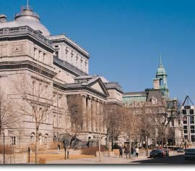
The Château Ramezay was one of the first
buildings in Québec to be declared a historic
monument. It is named for Claude de
Ramezay, Governor of Montréal, who had it
built as his home in 1705. The Château was
later sold to the Compagnie des Indes, which
held a monopoly on fur exports, and was remodelled and expanded in 1756,
partly on its original foundations. The building served as a Governor's residence
again and later as a military headquarters and courthouse, and finally was
turned into a museum in 1895. A turret, added in 1903, makes it look even more
like a castle, a name derived from its delightful architecture, typical of a hotel
particulier in the days of the fortified city.
Credit/Copyrights: http://www.vieux.montreal.qc.ca/
Montréal City Hall has a more turbulent
history than its peaceful façade suggests.
The building went up between 1872 and
1878, and survived a severe fire in 1922. And
it was from this balcony that French
President General de Gaulle uttered his
famous "Vive le Québec libre!" during a state
visit in 1967.
Credit/Copyrights: http://www.vieux.montreal.qc.ca/
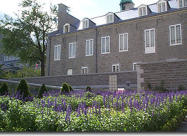
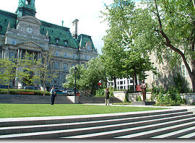
Bonsecours
The Bonsecours Market, a jewel in
Montréal's heritage crown, was inaugurated
in 1847. A symbol of Montréal's heyday, this
imposing building was the city's main
agricultural marketplace for over a century.
It also housed a concert hall and even
served as a city hall in the early days of
Montréal.
Its symmetrical composition and Greek Revival portico (the cast-iron columns
were brought from England), tin-plated dome and simple and varied details make
it a perfect illustration of the Neo-classical style in favour at the time. Recent
renovations have turned it once again into a bustling marketplace that also
features shops and exhibitions. Credit/Copyrights: http://www.vieux.montreal.qc.ca/
A beautiful house in the fortified town
The Pierre du Calvet house, built in 1770 and
nicely restored in 1966, is an impressive sight. But
in the 18th-century fortified town, the customers
of the owner, a Huguenot merchant and
supporter of the American Revolution, probably
saw nothing unusual about the building. With its
steeply pitched roof, its fieldstone walls secured
with "S"-shaped iron bars and its casement
windows, it was typical of the period. Note the
end walls, which extend above the line of the roof
as fire breaks. This type of construction became
mandatory after the great fire of 1721.
Credit/Copyrights: http://www.vieux.montreal.qc.ca/
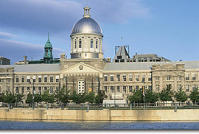
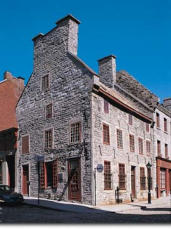
Place Jacques-Cartier
The square was built here by the city in the first
half of the 19th century, but this initiative was
simply an acknowledgement of a much older
reality. As archaeologists have found, people
have gathered at this site for generations. It has
always been one of the most popular spots in
Montréal! shops and exhibitions.
When the Bonsecours Market opened for
business in 1847, the "old" New Marketplace was
demolished and turned into Place Jacques-
Cartier. Market gardeners and craftspeople
continued to offer their wares as an outdoor
extension of the New Marketplace, however.
When the Bonsecours
Market opened for business in 1847, the "old" New
Marketplace was demolished and turned into Place
Jacques-Cartier. Market gardeners and craftspeople
continued to offer their wares as an outdoor extension
of the New Marketplace, however.
Built during the same period, these houses mark
changes in architectural styles after 1800, notably the
use of cut stone façades.
Credit/Copyrights:
http://www.vieux.montreal.qc.ca/
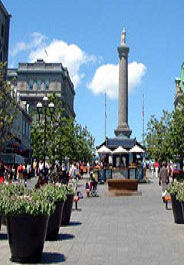
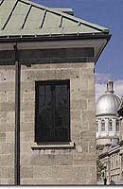
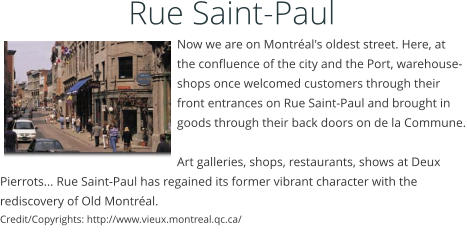
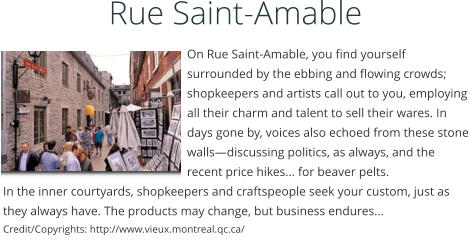
Direct Phone Number: 514-880-6372
Websites:
Montreal Photography Productions Services



Phone: 1-514-880-6372



















